Design of LTE/Sub-6 GHz Dual-Band Transparent Antenna Using Frame-Structured Metal Mesh Conductive Film
Abstract
:1. Introduction
2. Study of the Frame-Structured Metal Mesh Conductive Film
3. Simulation and Measured Results
4. Conclusions
Author Contributions
Funding
Institutional Review Board Statement
Informed Consent Statement
Data Availability Statement
Conflicts of Interest
References
- Ban, Y.L.; Li, C.; Sim, C.Y.D.; Wu, G.; Wong, K.L. 4G/5G Multiple Antennas for Future Multi-Mode Smartphone Applications. IEEE Access 2016, 4, 2981–2988. [Google Scholar] [CrossRef]
- Ko, M.; Lee, H.; Choi, J. Planar LTE/sub-6 GHz 5G MIMO antenna integrated with mmWave 5G beamforming phased array antennas for V2X applications. IET Microw. Antennas Propag. 2020, 14, 1283–1295. [Google Scholar] [CrossRef]
- Li, Q.L.; Cheung, S.W.; Wu, D.; Yuk, T.I. Optically Transparent Dual-Band MIMO Antenna Using Micro-Metal Mesh Conductive Film for WLAN System. IEEE Antennas Wirel. Propag. Lett. 2017, 16, 920–923. [Google Scholar] [CrossRef]
- Kosuga, S.; Suga, R.; Hashimoto, O.; Koh, S. Graphene-based optically transparent dipole antenna. Appl. Phys. Lett. 2017, 110, 233102. [Google Scholar] [CrossRef]
- Hong, S.; Kim, Y.; Jung, C.W. Transparent Microstrip Patch Antennas With Multilayer and Metal-Mesh Films. IEEE Antennas Wirel. Propag. Lett. 2017, 16, 772–775. [Google Scholar] [CrossRef]
- Desai, A.; Upadhyaya, T.; Palandoken, M.; Gocen, C. Dual band transparent antenna for wireless MIMO system applications. Microw. Opt. Technol. Lett. 2019, 61, 1845–1856. [Google Scholar] [CrossRef]
- Dao, Q.H.; Grundmann, L.; Geck, B. Optically Transparent 24 GHz Analog Front-End Based on Meshed Microstrip Lines for the Integration in a Self-Sufficient RFID Sensor Tag. IEEE J. Radio Freq. Identif. 2020, 4, 83–92. [Google Scholar] [CrossRef]
- Yazdani, R.; Yousefi, M.; Aliakbarian, H.; Oraizi, H.; Vandenbosch, G.A.E. Miniaturized Triple-Band Highly Transparent Antenna. IEEE Trans. Antennas Propag. 2020, 68, 712–718. [Google Scholar] [CrossRef]
- Song, H.J.; Hsu, T.Y.; Sievenpiper, D.F.; Hsu, H.P.; Schaffner, J.; Yasan, E. A Method for Improving the Efficiency of Transparent Film Antennas. IEEE Antennas Wirel. Propag. Lett. 2008, 7, 753–756. [Google Scholar] [CrossRef]
- Pucel, R.A.; Masse, D.J.; Hartwig, C.P. Losses in microstrip. IEEE Trans. Microw. Theory Tech. 1968, MT16, 342. [Google Scholar] [CrossRef]
- Gupta, K.C.; Garg, R.; Bahl, I.; Bhartia, P. Microstrip Lines and Slotlines, 2nd ed.; Artech House: Norwood, MA, USA, 1996. [Google Scholar]
- Collin, R.E. Foundations for Microwave Engineering; McGraw-Hill: New York, NY, USA, 1992. [Google Scholar]
- Cima NanoTech Company. 2016. Available online: http//www.cimananotech.com (accessed on 10 May 2016).
- Li, J.X.; Zhang, X.K.; Wang, Z.; Chen, X.M.; Chen, J.; Li, Y.S.; Zhang, A.X. Dual-Band Eight-Antenna Array Design for MIMO Applications in 5G Mobile Terminals. IEEE Access 2019, 7, 71636–71644. [Google Scholar] [CrossRef]
- Sharawi, M.S. Current Misuses and Future Prospects for Printed Multiple-Input, Multiple-Output Antenna Systems. IEEE Antennas Propag. Mag. 2017, 59, 162–170. [Google Scholar] [CrossRef]
- Blanch, S.; Romeu, J.; Corbella, I. Exact representation of antenna system diversity performance from input parameter description. Electron. Lett. 2003, 39, 705–707. [Google Scholar] [CrossRef] [Green Version]
- Nasir, J.; Jamaluddin, M.H.; Khan, A.A.; Kamarudin, M.R.; Leow, C.Y.; Owais, O. Throughput Measurement of a Dual-Band MIMO Rectangular Dielectric Resonator Antenna for LTE Applications. Sensors 2017, 17, 148. [Google Scholar] [CrossRef] [PubMed] [Green Version]
- Rosengren, K.; Kildal, P.S. Radiation efficiency, correlation, diversity gain and capacity of a six-monopole antenna array for a MIMO system: Theory, simulation and measurement in reverberation chamber. IEEE Proc.-Microw. Antennas 2005, 152, 7–16. [Google Scholar] [CrossRef]
- Sharawi, M.S. Printed Multi-Band MIMO Antenna Systems and Their Performance Metrics. IEEE Antennas Propag. Mag. 2013, 55, 218–232. [Google Scholar] [CrossRef]
- Sayem, A.M.; Simorangkir, R.; Esselle, K.P.; Hashmi, R.M. Development of Robust Transparent Conformal Antennas Based on Conductive Mesh-Polymer Composite for Unobtrusive Wearable Applications. IEEE Trans. Antennas Propag. 2019, 67, 7216–7224. [Google Scholar] [CrossRef]
- Eltresy, N.A.; Abd Elhamid, A.M.; Elsheakh, D.N.; Abdallah, E.A.; Elhennawy, H.M. AgITO for high-performance semi-transparent wideband antenna applications. Electron. Lett. 2020, 56, 749. [Google Scholar] [CrossRef]
- Ameen, M.; Ahmad, O.; Chaudhary, R.K. Single split-ring resonator loaded self-decoupled dual-polarized MIMO antenna for mid-band 5G and C-band applications. AEU-Int. J. Electron. Commun. 2020, 124, 153336. [Google Scholar] [CrossRef]
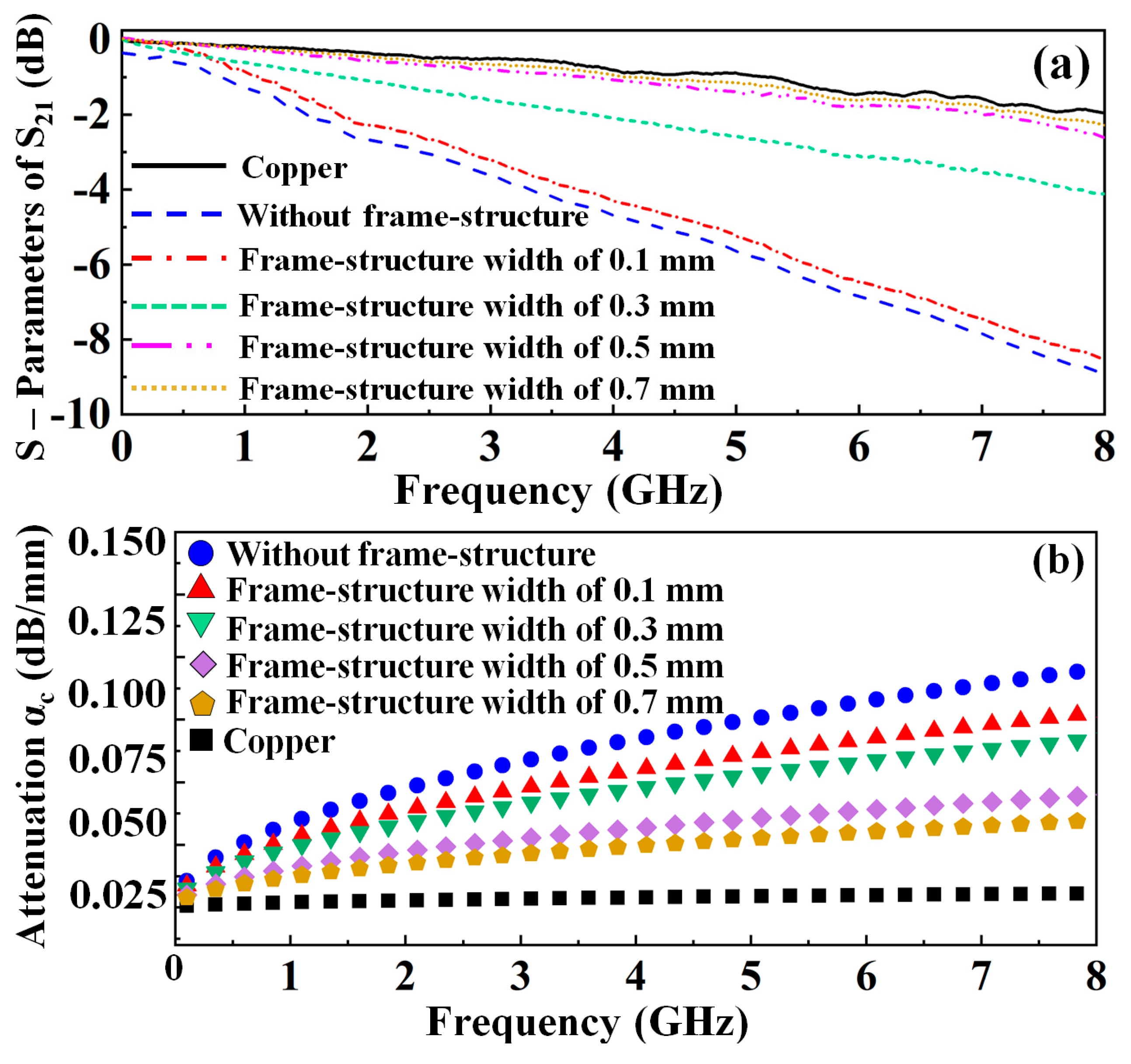
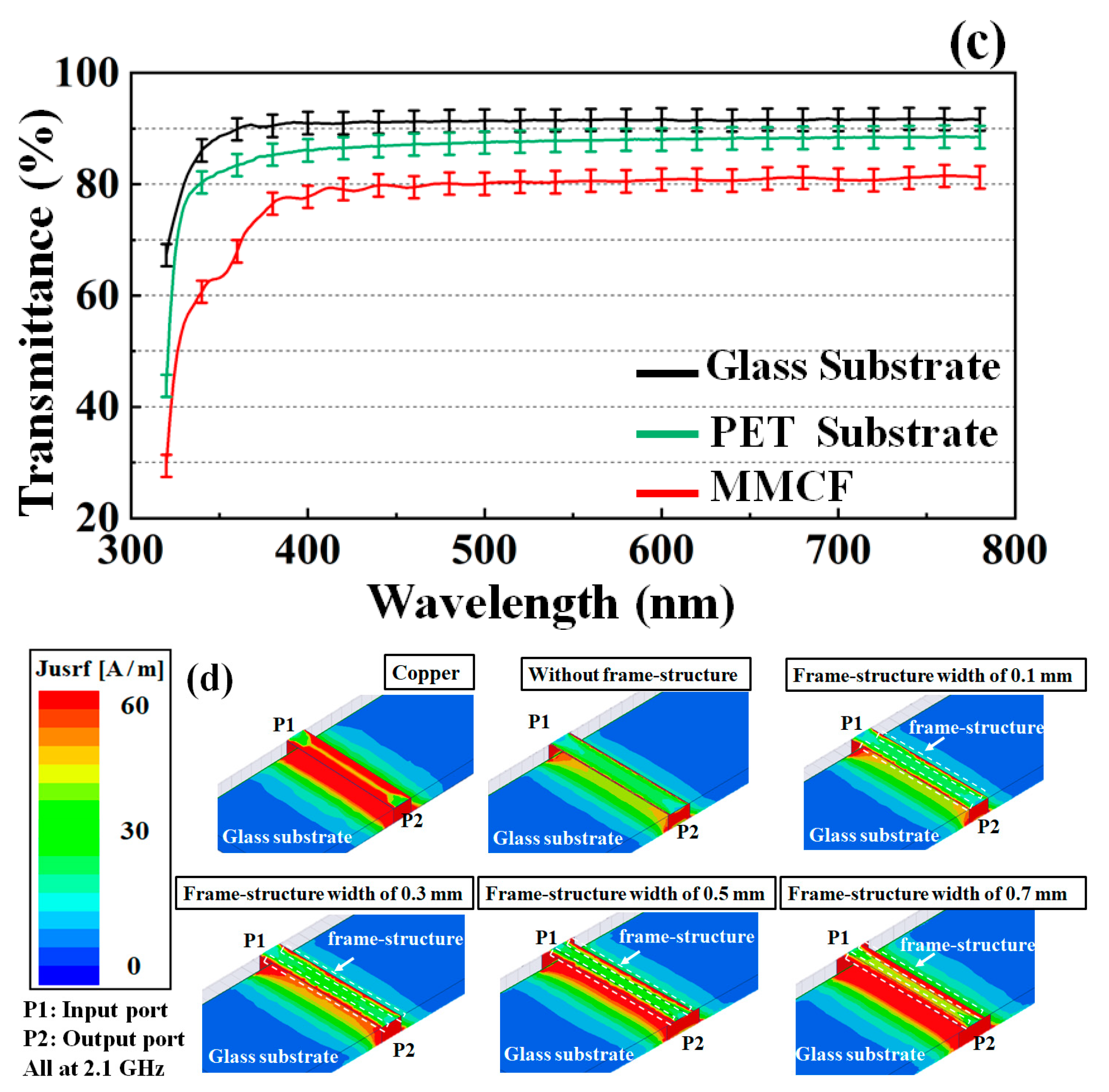
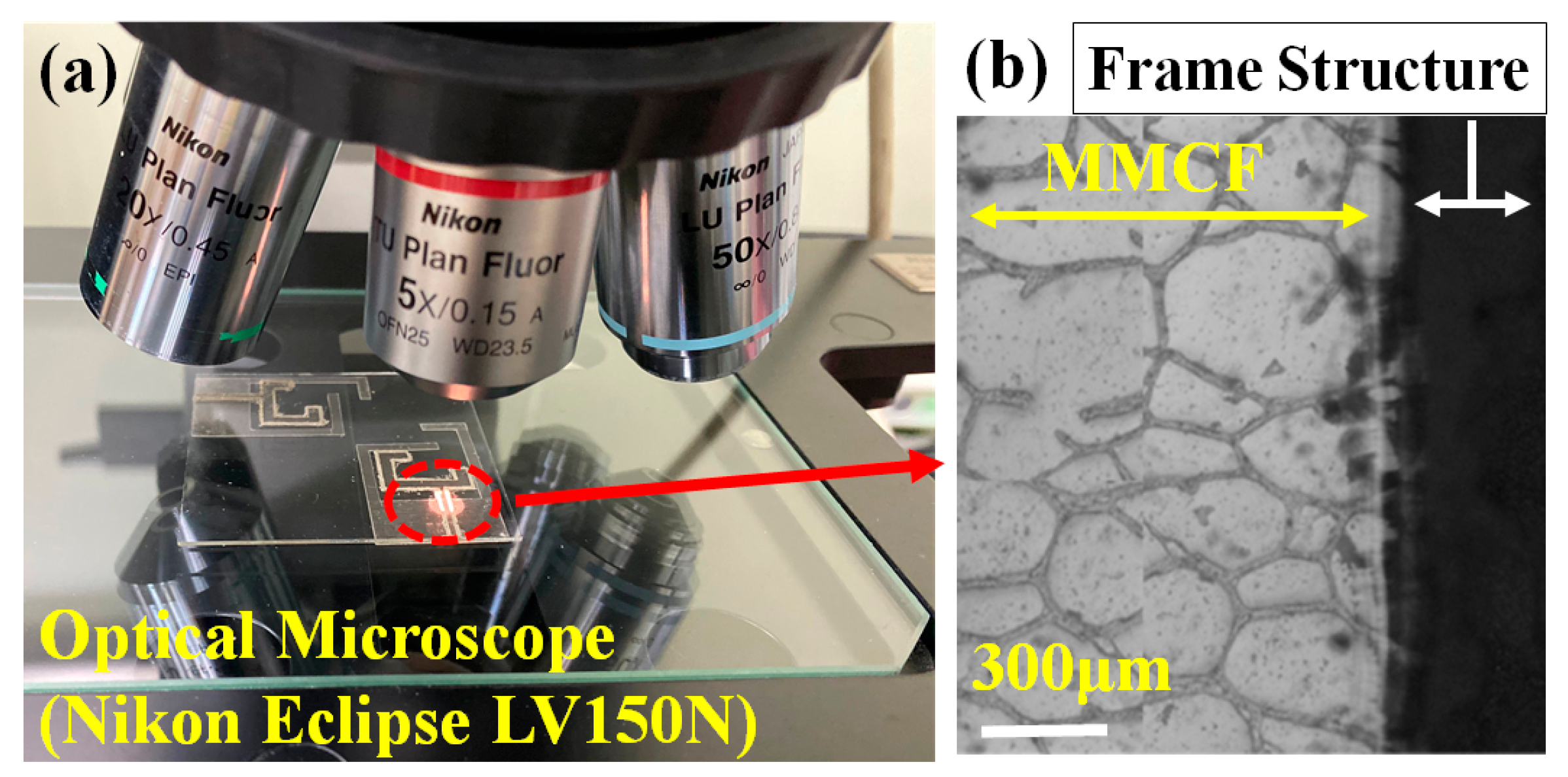
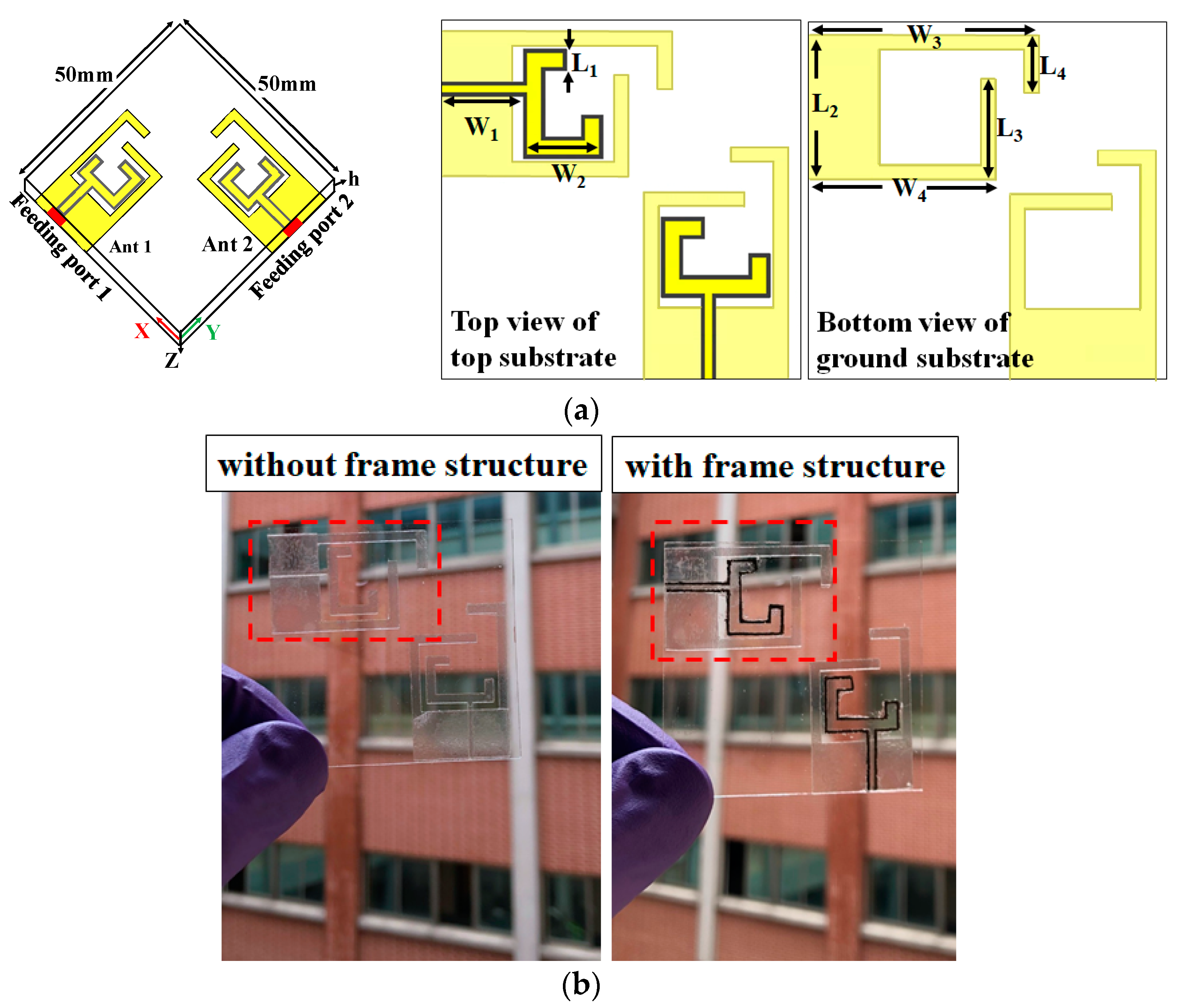
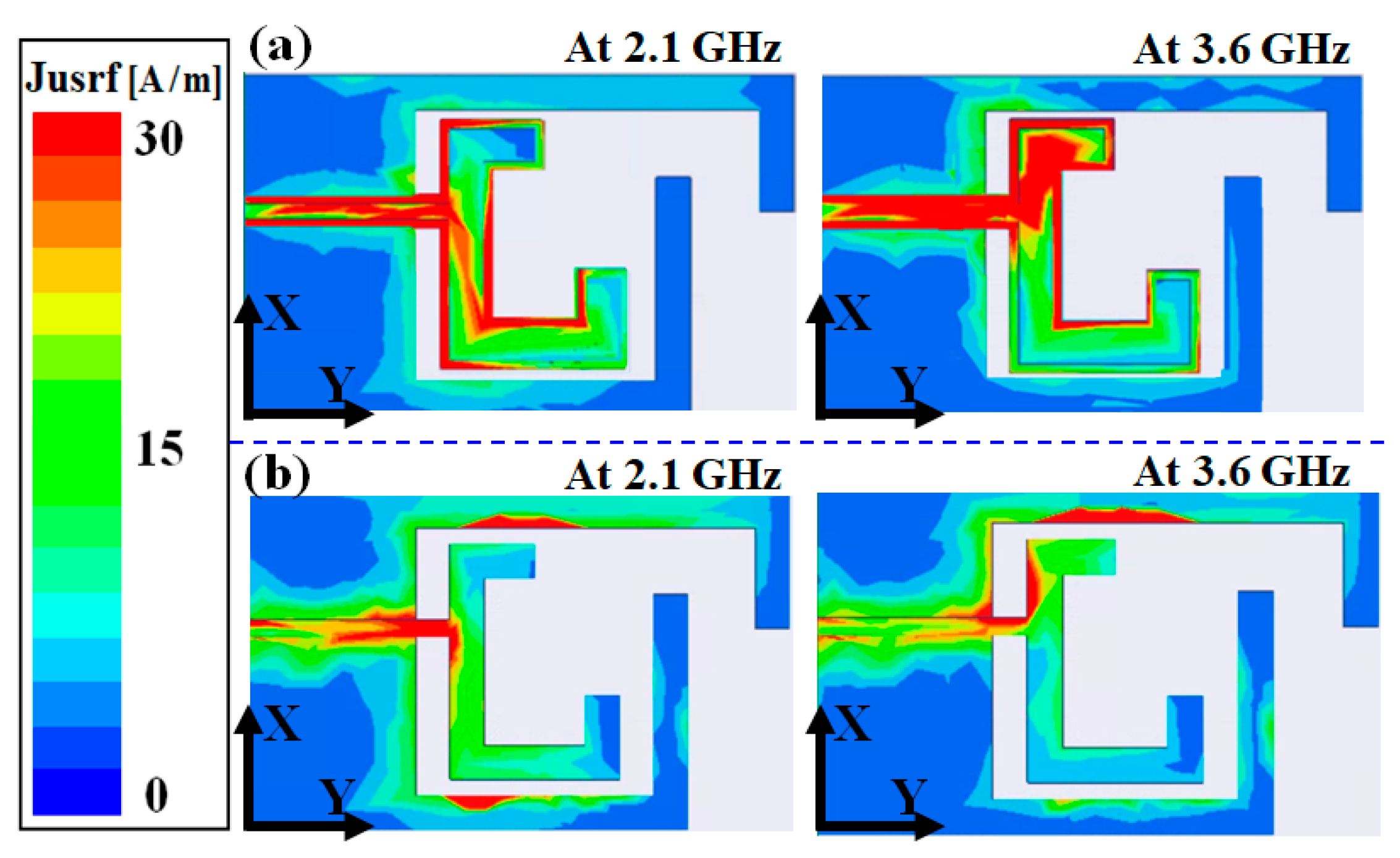



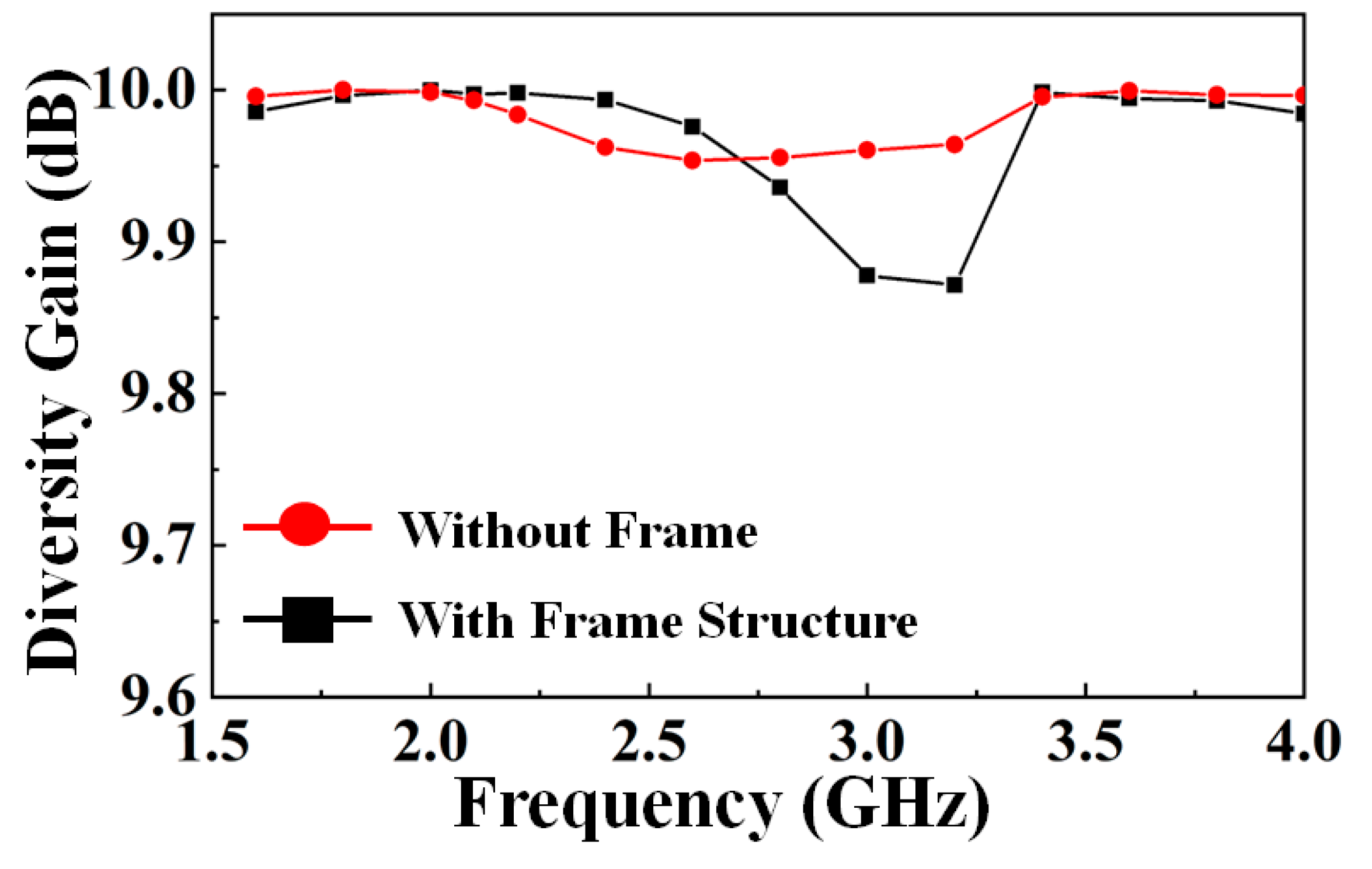

| Ref. | Film Structure/Substrate | f0 (GHz) | |S11| (dB) | Efficiency (%) | Gain (dB) | Transmittance (%) |
|---|---|---|---|---|---|---|
| [3] | MMCF/Glass | 2.44/5.5 | 25/18 | 43/46 | 0.74/2.3 | 75 |
| [4] | Graphene and Au/Glass | 20.7 | 11 | × | × | × |
| [5] | MMF/Acrylic | 2.47 | 15 | 42.7 | 2.63 | 61.5 |
| [6] | Metal Mesh/Glass | 24 | 19 | 49 | 4.4 | 75 |
| [20] | Copper/PDMS | 2.43/5.15 | 27.8/18 | 37/44 | 2.2/3.02 | 70 |
| [21] | AgITO/Glass | 3.5/5.8 | 27/23 | × | −2.9/−3 | 52 |
| [22] | Copper/FR-4 | 3.54/6.33 | 32/23 | 75.1/74.2 | 3.25/3.4 | 0 |
| This work | frame-structured MMCF/Glass | 2.1/3.6 | 25.6/15.2 | 51/53 | −9.5/−6.1 | 80 |
Disclaimer/Publisher’s Note: The statements, opinions and data contained in all publications are solely those of the individual author(s) and contributor(s) and not of MDPI and/or the editor(s). MDPI and/or the editor(s) disclaim responsibility for any injury to people or property resulting from any ideas, methods, instructions or products referred to in the content. |
© 2023 by the authors. Licensee MDPI, Basel, Switzerland. This article is an open access article distributed under the terms and conditions of the Creative Commons Attribution (CC BY) license (https://creativecommons.org/licenses/by/4.0/).
Share and Cite
Lin, Y.-M.; Wu, H.-W.; Chang, S.-J. Design of LTE/Sub-6 GHz Dual-Band Transparent Antenna Using Frame-Structured Metal Mesh Conductive Film. Nanomaterials 2023, 13, 221. https://doi.org/10.3390/nano13020221
Lin Y-M, Wu H-W, Chang S-J. Design of LTE/Sub-6 GHz Dual-Band Transparent Antenna Using Frame-Structured Metal Mesh Conductive Film. Nanomaterials. 2023; 13(2):221. https://doi.org/10.3390/nano13020221
Chicago/Turabian StyleLin, Yu-Ming, Hung-Wei Wu, and Shoou-Jinn Chang. 2023. "Design of LTE/Sub-6 GHz Dual-Band Transparent Antenna Using Frame-Structured Metal Mesh Conductive Film" Nanomaterials 13, no. 2: 221. https://doi.org/10.3390/nano13020221




